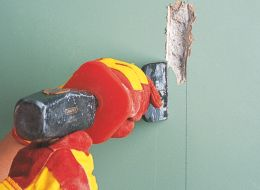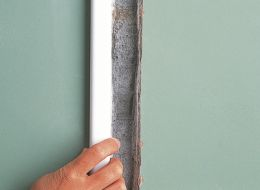Thinking about getting the walls re-plastered so might as well install some more wiring. Power and networking.
Anyone done this? Is cat6 the way to go? How about things like skirting board with channels for wires? In the UK we don’t have drywall…
Thinking about getting the walls re-plastered so might as well install some more wiring. Power and networking.
Anyone done this? Is cat6 the way to go? How about things like skirting board with channels for wires? In the UK we don’t have drywall…
Not sure about UK but US pretty much requires the plenum cable that is flame retardant. Also in the US its required to be in a separate raceway from the power. I would imagine its similar for you and would recommend it this way anyway. Cat6 would be my choice. I might even opt for the shielded stuff. The finishing board stuff isnt a bad way to go but running in the wall will leave a nicer finish since the network cable has to terminate somewhere.
install conduit so you can easily pull new wire later on if you need to
Make sure it’s fiber as well! Don’t you dare dissapoint the community!
QSFP28 of GTFO!
Seriously,
^this is the best advice on the subject
Cat6 is rated to 1GB but can get upto 10GBS for shorter runs. Cat6a is rated to 10GB, You can do all the work yourself, with only a small investment in tools, avoid fiber! all the equipment is expensive!!!
Could do a “main axis” of fibre to the important rooms and branch out in copper from there.
Used fibre gear is affordable.
I would have to agree with the13thxen Fiber equipment is very expensive. Keep in mind the aforementioned sentence is only my opinion based on the extensive research I have done when I was considering Fiber for wiring up my house. Also, there are two drawbacks the13thxen didn’t mention; they are Fiber isn’t a do yourself project, and the cost per socket.
When I was looking at using Fiber instead of Ethernet Cat 6 to completely wire up my house, I can to the realization it isn’t a do yourself project. You need special equipment and knowledge to properly terminate Fiber, its a lot more difficult to work with than Ethernet, I couldn’t find a local tool rental shop where I could rent the equipment even if I knew how to properly use it. So for the aforementioned reason, I decided against Fiber and have decided to go with either Cat 5e or Cat 6, when Spring comes this year.
I also forgot to mention another consideration when considering dealing with Fiber the cost per socket. During my research, I came to the realization the increased cost of installing Fiber was so much more than Ethernet. I couldn’t justify the increased cost unless I worked at home or I ran a Business through my home. I found out to install fiber in my house would cost $450 per connection when Ethernet would be about $50 per connection including labor.
Thanks guys. Conduit, definitely…
I think I will stick with Cat 6 because I know it, and everything is cheap and easy. Patch panels, switches, everything. 1Gb is enough for me. Also POE for cameras and stuff.
I was hoping that WiGig might be available but it looks to be a year or two away for affordable, decent hardware. The V1 stuff is always crap.
Was hoping someone had tried out different conduit tech like the skirting boards and even just the in-wall stuff. Want to get good stuff.
Is your goal to install conduit in wall, or surface mount? For in wall you could use what we call “Smurf Tube” or by it’s official name “ENT”. It can be fished in existing walls. I fished it in my exterior walls prior to installing spray foam insulation. For interior walls, I just fished cable in the wall.
When installing any conduit try to keep bends to a minimum to make pulling the wire easier and never have more than 360 degree’s of total bends between pull points.
For surface mounting in unfinished areas that may be susceptible to damage I would use EMT. For surface mounting in finished areas I would probably use some form of Wiremold.
I’ve used that quarter round trim for speaker wire. Its ok but it still doesnt feel right to me.
@DIffident, the walls need to be re-skimmed so might as well get in-wall conduit, but I’m thinking that inevitably I’ll want to move things around eventually.
Thanks @Adubs, that’s helpful.
One other thing I was thinking is custom power cables. Always end up too many - computer, monitors, USB hubs, scanner, printer, amplifier, chargers. In the UK every device is supposed to be separately fused and our plugs are massive, plus the minimum cable you can buy is 3A so not exactly small and flexible. More of desk org question though.
my two cents on how to-do it in a UK house. Chase the walls, put some CAT6(A) with some capping on top; run all your cables thru the ceiling to a central point (most likely under the stairs?) and re-skim the walls.
A few words I don’t know the context;
“chase” the walls?
“capping” on top?
1, 
2, 
its pretty common knowledge what a chase is and capping is a building reg required to protect the cables inside of walls
You will also need a cable detector, so you wont hit a power cable while chase the wall.
And the cat5,6 ,7 can’t be longer than 100m or you will get data lost.
I am not sure what the range of PoE is, it might depend on the router/switch u will using, but I think its far les then 100m. Keep that in mind too.
Thanks.
Over here a chase is used to refer to a build out from the main wall to house a chimney.
Capping in my job means using a brake to bend thin aluminum sheet to cover exterior wood windows and doors.
Not all terms are universal throughout the world, or countries, or even provinces.
EG;
boot = trunk
bonnet = hood
I could go on…
@MLWALK3R My loft has some rooms so I was thinking of using that for a patch panel and switch. It’s easy to access, and there isn’t much that go wrong with a switch anyway (famous last words). Not sure what type to get yet, maybe something managed. I want to use VLANs to keep some IoS devices separate from the main LAN and cut off from the internet.
@Suleiman, that’s a good point about PoE, I will keep it in mind.
as an electrician (spark to uk fellows) this is a nec requirement but a good rule of thumb to follow for the reason is the friction from pulling more than 360 degrees (even with lube) can abrade insulation to the point it fails testing and or causes short circuits.
emt conduit will probably be sufficient and in effect shield the communication cabling from emi from nearby power circuits.
conduit allows for future upgrades with ease. (for example foam insulation in a wall will cement cabling into place making it difficult to remove and upgrading would generally mean surface mount types of raceway)
while fiber-optic is expensive the benefits can shortly pay for the high cost of installation.
No emi!, Much higher bandwidth and typical network plenum cabling has a lot smaller profile than its copper counterpart so many more cables can fit in the conduit without de-rating,
also fiber-optic cables can be run in the same raceway as power cables without causing emi issues
Power over ethernet for yard and room extensions as then its just ethernet cable needed no wall power except at poe injector device and give wired point to point of wlan extenders